Field Electron Emission Experiments with Cold-Sprayed Cu-SiC Composite Coatings
Abstract
:1. Introduction
2. Materials and Methods
2.1. Materials
- -
- electrolytic copper powder with dendritic shape with particle sizes of 7 to 50 µm, noted as E-Cu;
- -
- gas atomized copper powder with spherical shape with particle sizes of 10 to 40 µm, called O-Cu.
2.2. Spraying Process Parameters
2.3. Coatings Characterization
2.4. Field Electron Emission Tests
3. Results
4. Discussion
5. Conclusions
Author Contributions
Funding
Institutional Review Board Statement
Informed Consent Statement
Data Availability Statement
Acknowledgments
Conflicts of Interest
References
- Anguero, V.M.; Adamo, R.C. Space Applications of Spindt Cathode Field Emission Arrays. In Proceedings of the 6th Space-Craft Charging Conference, Hanscom AFB, MA, USA, 2–6 November 1998; pp. 347–352. [Google Scholar]
- Matéo-Vélez, J.-C.H.; Belhaj, M.; Roussel, J.-F.; Rodgers, D.; Cipriani, F. Design and Numerical Assessment of a Passive Electron Emitter for Spacecraft Charging Alleviation. IEEE Trans. Plasma Sci. 2015, 43, 2839–2848. [Google Scholar] [CrossRef]
- Fléron, R.A.W.; Blanke, M. Electron Emitter for Small-Size Electrodynamic Space-Tether Using Mems Technology. In Proceedings of the ESA Symposium on Small Spacecraft Systems, La Rochelle, France, 20–24 September 2004; European Space Agency: Noordwijk, The Netherlands, 2004; pp. 227–232. [Google Scholar]
- Czarczynski, W.; Znamirowski, Z. Field electron emission experiments with plasma sprayed layers. Surf. Coat. Technol. 2008, 202, 4422–4427. [Google Scholar] [CrossRef]
- Spindt, C.A. A Thin-Film Field-Emission Cathode. J. Appl. Phys. 1968, 39, 3504–3505. [Google Scholar] [CrossRef]
- Luo, J.; Liu, L.; Sun, F.; Tang, X.; Zheng, R.-T.; Wu, X.-L.; Cheng, G.-A. Effect of purification methods on the cross-sectional field emission properties of carbon nanotube and graphene composite films. Diam. Relat. Mater. 2020, 106, 107848. [Google Scholar] [CrossRef]
- Shiroishi, T.; Hosono, A.; Sono, A.; Nishimura, K.; Suzuki, Y.; Nakata, S.; Okuda, S. Improvement of emission characteristics uniformity of carbon nanotube field emission display by surface treatment. J. Vac. Sci. Technol. B Microelectron. Nanometer Struct. 2006, 24, 979. [Google Scholar] [CrossRef]
- Kimura, C.; Yamamuro, Y.; Aoki, H.; Sugino, T. Improved field emission characteristics of carbon nanofiber treated with nitrogen plasma. Diam. Relat. Mater. 2007, 16, 1383–1387. [Google Scholar] [CrossRef]
- Forbes, R.G. Low-macroscopic-field electron emission from carbon films and other electrically nanostructured heterogeneous materials: Hypotheses about emission mechanism. Solid-State Electron. 2001, 45, 779–808. [Google Scholar] [CrossRef]
- Sunab, L.; Chenb, E.; Guob, T. Field emission enhancement of composite structure of ZnO quantum dots and CuO nanowires by Al2O3 transition layer optimization. Ceram. Int. 2020, 46, 15565–15571. [Google Scholar] [CrossRef]
- Wu, X.; Wang, Y.; Yang, P. The field emission properties from the pristine/B-doped graphene–C 70 composite. Phys. Lett. A 2017, 381, 2004–2009. [Google Scholar] [CrossRef]
- Wu, Y.; Li, J.; Ye, J.; Song, Y.; Chen, X.; Huang, S.; Sun, Z.; Ou-Yang, W. Outstanding field emission properties of titanium dioxide /carbon nanotube composite cathodes on 3D nickel foam. J. Alloys Compd. 2017, 726, 675–679. [Google Scholar] [CrossRef]
- Litovchenko, V.; Evtukh, A.; Kryuchenko, Y.; Goncharuk, N.; Yilmazoglu, O.; Mutamba, K.; Hartnagel, H.; Pavlidis, D. Quantum-size resonance tunneling in the field emission phenomenon. J. Appl. Phys. 2004, 96, 867–877. [Google Scholar] [CrossRef]
- Wang, H.; Jiang, W.; Kang, L.; Li, Z. Photoluminescence and electron field-emission properties of SiC-SiO2 core-shell fibers and 3C–SiC nanowires on silicon nanoporous pillar array. J. Alloys Compd. 2013, 553, 125–128. [Google Scholar] [CrossRef]
- Matallana, A.; Ibarra, E.; López, I.; Andreu, J.; Garate, J.; Jordà, X.; Rebollo, J. Power module electronics in HEV/EV applications: New trends in wide-bandgap semiconductor technologies and design aspects. Renew. Sustain. Energy Rev. 2019, 113. [Google Scholar] [CrossRef]
- Lelis, A.J.; Green, R.; Habersat, D.B.; El, M. Basic Mechanisms of Threshold-Voltage Instability and Implications for Reliability Testing of SiC MOSFETs. IEEE Trans. Electron Devices 2015, 62, 316–323. [Google Scholar] [CrossRef]
- Masri, P. Silicon carbide and silicon carbide-based structures. Surf. Sci. Rep. 2002, 48, 1–51. [Google Scholar] [CrossRef]
- Buttay, C.; Planson, D.; Allard, B.; Bergogne, D.; Bevilacqua, P.; Joubert, C.; Lazar, M.; Martin, C.; Morel, H.; Tournier, D.; et al. State of the art of high temperature power electronics. Mater. Sci. Eng. B 2011, 176, 283–288. [Google Scholar] [CrossRef] [Green Version]
- Ying, P.-Z.; Chen, S.; Ren, X.-L.; Chen, Q. Investigation of temperature on the field electron emission from flexible N-doped SiC nanoneedles. Superlattices Microstruct. 2015, 86, 250–255. [Google Scholar] [CrossRef]
- Deng, J.-H.; Sun, P.-C.; Cheng, G.-A.; Zheng, R. Improved field electron emission from SiC assisted carbon nanorod/nanotube heterostructured arrays by using energetic Si ion irradiation. Surf. Coat. Technol. 2013, 228, S323–S327. [Google Scholar] [CrossRef]
- Winnicki, M.; Malachowska, A.; Baszczuk, A.; Rutkowska-Gorczyca, M.; Kukla, D.; Lachowicz, M.; Ambroziak, A. Corrosion protection and electrical conductivity of copper coatings deposited by low-pressure cold spraying. Surf. Coat. Technol. 2017, 318, 90–98. [Google Scholar] [CrossRef]
- Kumar, S.D.; Ravichandran, M.; Sakthivelu, S.; Meignanamoorthy, M.; Chanakyan, C.; Alagarsamy, S. Mechanical properties of magnesium-silicon carbide composite fabricated through powder metallurgy route. Mater. Today Proc. 2020, 27, 1137–1141. [Google Scholar] [CrossRef]
- Kee, S.-H.; Kim, W.-J.; Jung, J.-P. Copper-silicon carbide composite plating for inhibiting the extrusion of through silicon via (TSV). Microelectron. Eng. 2019, 214, 5–14. [Google Scholar] [CrossRef]
- Chmielewski, M.; Nosewicz, S.; Wyszkowska, E.; Kurpaska, Ł.; Strojny-Nędza, A.; Piątkowska, A.; Bazarnik, P.; Pietrzak, K. Analysis of the micromechanical properties of copper-silicon carbide composites using nanoindentation measurements. Ceram. Int. 2019, 45, 9164–9173. [Google Scholar] [CrossRef]
- Kaur, G.; Kumar, R.; Lahiri, I. Field electron emission from protruded GO and rGO sheets on CuO and Cu nanorods. Phys. E Low-Dimens. Syst. Nanostruct. 2019, 112, 10–18. [Google Scholar] [CrossRef]
- Tzeng, Y.; Liu, C.; Hirata, A. Effects of oxygen and hydrogen on electron field emission from microwave plasma chemically vapor deposited microcrystalline diamond, nanocrystalline diamond, and glassy carbon coatings. Diam. Relat. Mater. 2003, 12, 456–463. [Google Scholar] [CrossRef]
- Roy, R.; Gupta, S.; Deb, B.; Pal, A. Electron field emission properties of electro-deposited diamond-like carbon coatings. Vacuum 2003, 70, 543–549. [Google Scholar] [CrossRef]
- Zhai, C.; Yun, J.; Zhao, L.; Zhang, Z.; Wang, X.-W.; Chen, Y. Effect of annealing on field emission properties of nanodiamond coating. Phys. B Condens. Matter 2011, 406, 1124–1128. [Google Scholar] [CrossRef]
- Waldmann, O.; Persaud, A.; Kapadia, R.; Takei, K.; Allen, F.I.; Javey, A.; Schenkel, T. Effects of palladium coating on field-emission properties of carbon nanofibers in a hydrogen plasma. Thin Solid Films 2013, 534, 488–491. [Google Scholar] [CrossRef]
- Jiang, R.; Zeng, B.; Liu, J.; Chai, X.; Chen, T.; Wu, Z.; Zhang, X.; Yang, K. Enhanced field electron emission of single-walled carbon nanotubes prepared by imprinting technique. J. Alloys Compd. 2020, 816, 152669. [Google Scholar] [CrossRef]
- Bankar, P.K.; Kolhe, P.S.; Mutadak, P.R.; Kawadeb, A.; Sonawane, K.M.; More, M.A. Evaluation of field electron emission properties of ZnIn2S4 nanopetals grown on conducting carbon substrate. Phys. E Low-Dimens. Syst. Nanostruct. 2021, 125, 114363. [Google Scholar] [CrossRef]
- Yang, Y.; Wang, L.-J.; Wang, X.-P.; Chen, J.-X.; Yang, X.-W.; Li, M.-H.; Deng, M.-J. Perovskite-type SrTiO3 thin film preparation and field emission properties. Vacuum 2020, 178, 109466. [Google Scholar] [CrossRef]
- Li, J.; Luo, Z. Fabrication and performances of preceramic polymer-based high-temperature High emissivity coating. J. Eur. Ceram. Soc. 2020, 40, 5217–5225. [Google Scholar] [CrossRef]
- Wang, X.-P.; Li, M.-H.; Guo, M.-M.; Wang, L.-J.; Yang, X.-W.; Yang, Y.; Deng, G.-R.M.-J.; Yang, G.-R.; Qian, Y.-T. Effect of metal coating material on field emission of vertically grown layered MoS2 nanosheets. Vacuum 2020, 177, 109386. [Google Scholar] [CrossRef]
- Znamirowski, Z.; Pawłowski, L.; Cichy, T.; Czarczynski, W. Low macroscopic field electron emission from surface of plasma sprayed and laser engraved TiO2, Al2O3+13TiO2 and Al2O3+40TiO2 coatings. Surf. Coat. Technol. 2004, 187, 37–46. [Google Scholar] [CrossRef]
- Tomaszek, R.; Znamirowski, Z.; Pawlowski, L.; Zdanowski, J. Effect of Conditioning on Field Electron Emission of Sus-pension Plasma Sprayed TiO2 Coatings. Vacuum 2007, 81, 1278–1282. [Google Scholar] [CrossRef]
- Znamirowski, Z.; Ladaczek, M. Lighting segment with field electron titania cathode made using suspension plasma spraying. Surf. Coat. Technol. 2008, 202, 4449–4452. [Google Scholar] [CrossRef]
- Champagne, V.K. The Cold Spray Materials Deposition Process, 1st ed.; Woodhead Publishing Ltd.: Cambridge, UK, 2007. [Google Scholar]
- Assadi, H.; Schmidt, T.; Richter, H.; Kliemann, J.-O.; Binder, K.; Gärtner, F.; Klassen, T.; Kreye, H. On Parameter Selection in Cold Spraying. J. Therm. Spray Technol. 2011, 20, 1161–1176. [Google Scholar] [CrossRef]
- Li, C.-J.; Wang, H.-T.; Zhang, Q.; Yang, G.-J.; Li, W.-Y.; Liao, H.L. Influence of Spray Materials and Their Surface Oxidation on the Critical Velocity in Cold Spraying. J. Therm. Spray Technol. 2009, 19, 95–101. [Google Scholar] [CrossRef]
- Wang, Y.; Normand, B.; Mary, N.; Yu, M.; Liao, H. Microstructure and corrosion behavior of cold sprayed SiCp/Al 5056 composite coatings. Surf. Coat. Technol. 2014, 251, 264–275. [Google Scholar] [CrossRef]
- Arrabal, R.; Pardo, A.; Merino, M.C.; Mohedano, M.; Casajús, P.; Merino, S. Al/SiC thermal spray coatings for corrosion protection of Mg-Al alloys in humid and saline environments. Surf. Coat. Technol. 2010, 204, 2767–2774. [Google Scholar] [CrossRef]
- Altman, I.S.; Pikhitsa, P.V.; Choi, M. Electron field emission from nanocarbons: A two-process model. Appl. Phys. Lett. 2004, 84, 1126–1128. [Google Scholar] [CrossRef]
- Schmidt, T.; Gärtner, F.; Assadi, H.; Kreye, H. Development of a generalized parameter window for cold spray deposition. Acta Mater. 2006, 54, 729–742. [Google Scholar] [CrossRef]
- Szala, M.; Łatka, L.; Walczak, M.; Winnicki, M. Comparative study on the cavitation erosion and sliding wear of cold-sprayed Al/Al2O3 and Cu/Al2O3 coatings, and stainless steel, aluminium alloy, copper and brass. Metals 2020, 10, 856. [Google Scholar] [CrossRef]
- Teo, K.B.K.; Lee, S.-B.; Chhowalla, M.; Semet, V.; Binh, V.T.; Groening, O.; Castignolles, M.; Loiseau, A.; Pirio, G.; Legagneux, P.; et al. Plasma enhanced chemical vapour deposition carbon nanotubes/nanofibres how uniform do they grow? Nanotechnology 2003, 14, 204–211. [Google Scholar] [CrossRef] [Green Version]
- Milne, W.; Teo, K.; Chhowalla, M.; Amaratunga, G.; Pribat, D.; Legagneux, P.; Pirio, G.; Binh, V.T.; Semet, V. Electron emission from arrays of carbon nanotubes/fibres. Curr. Appl. Phys. 2002, 2, 509–513. [Google Scholar] [CrossRef]
- Su, C.-Y.; Juang, Z.-Y.; Chen, Y.; Leou, K.; Tsai, C. The field emission characteristics of carbon nanotubes coated by boron nitride film. Diam. Relat. Mater. 2007, 16, 1393–1397. [Google Scholar] [CrossRef]
- Hong, X.; Zheng, H.; Liang, D. Stable electron field emission from graphene/hexagonal boron nitride hybrid structure. Mater. Lett. 2020, 277, 128356. [Google Scholar] [CrossRef]
- Znamirowski, Z.; Posadowski, W.; Pawłowski, L.; Cattini, A.; Latka, L. Electron emission from the zirconium coated suspension plasma sprayed bioglass. Surf. Coat. Technol. 2015, 268, 63–69. [Google Scholar] [CrossRef]
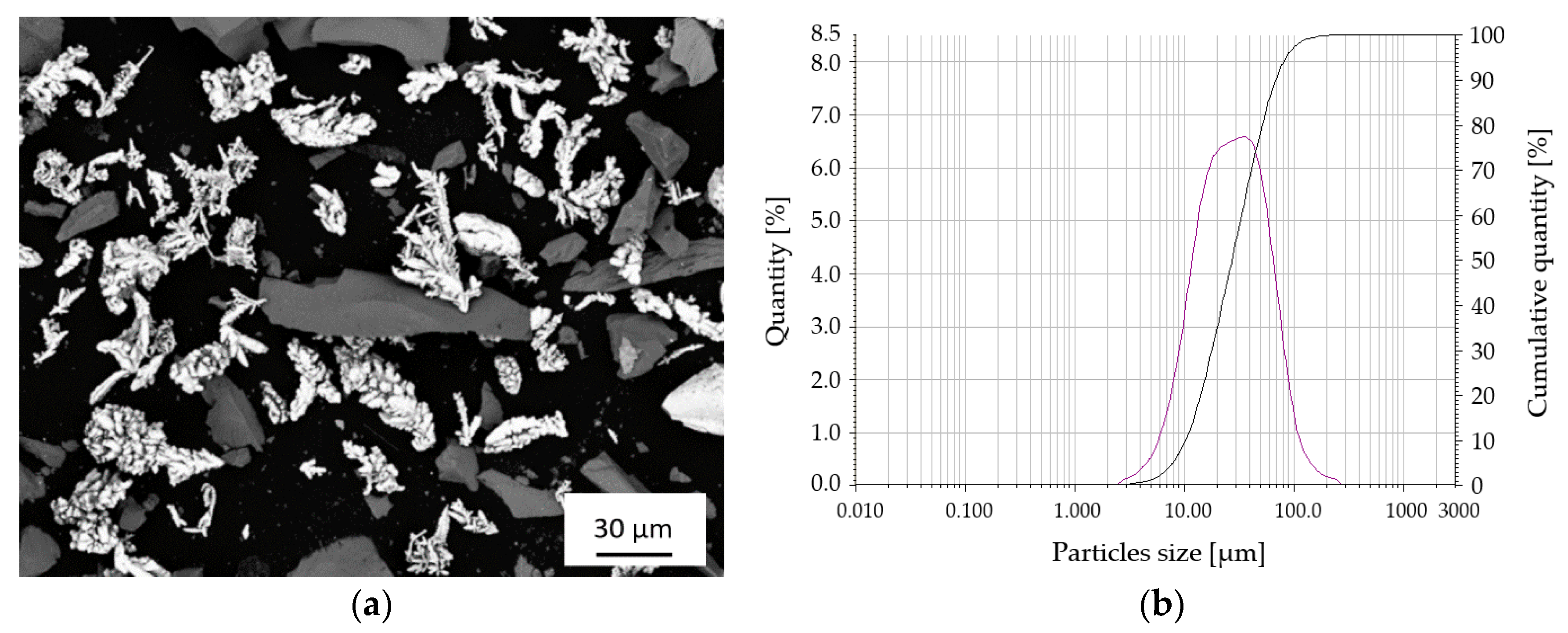
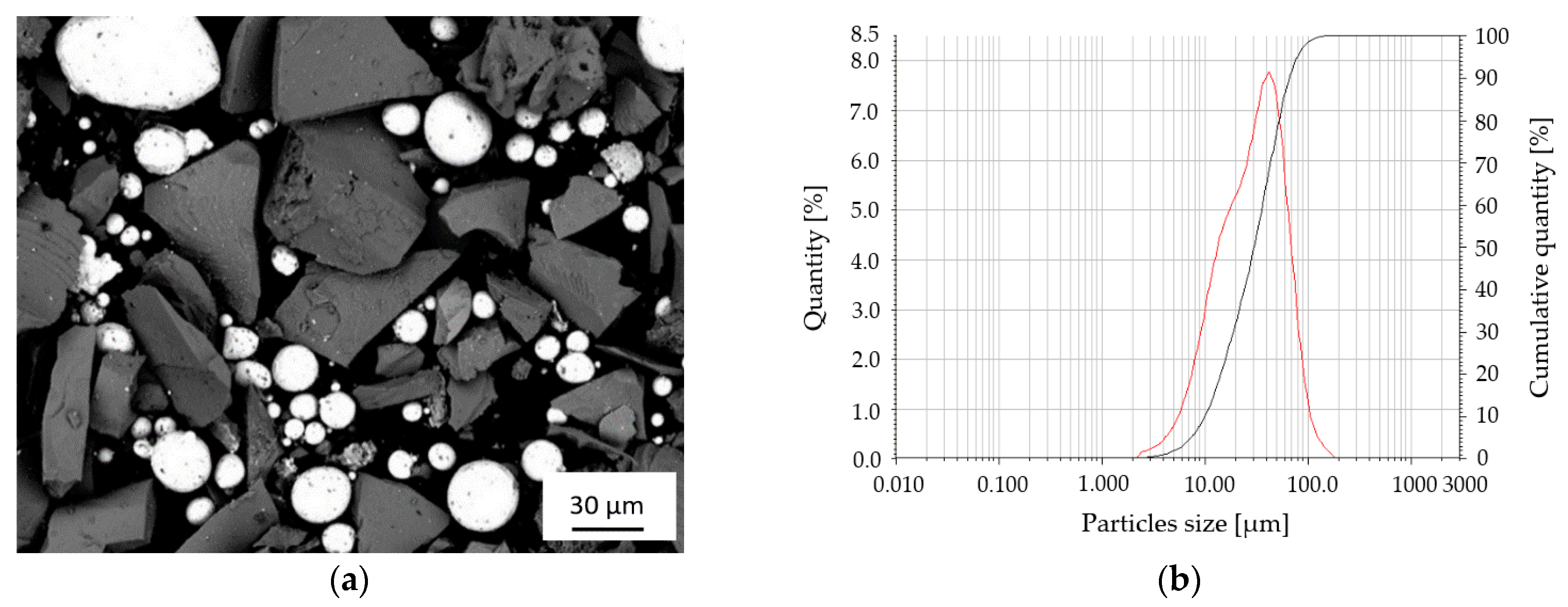



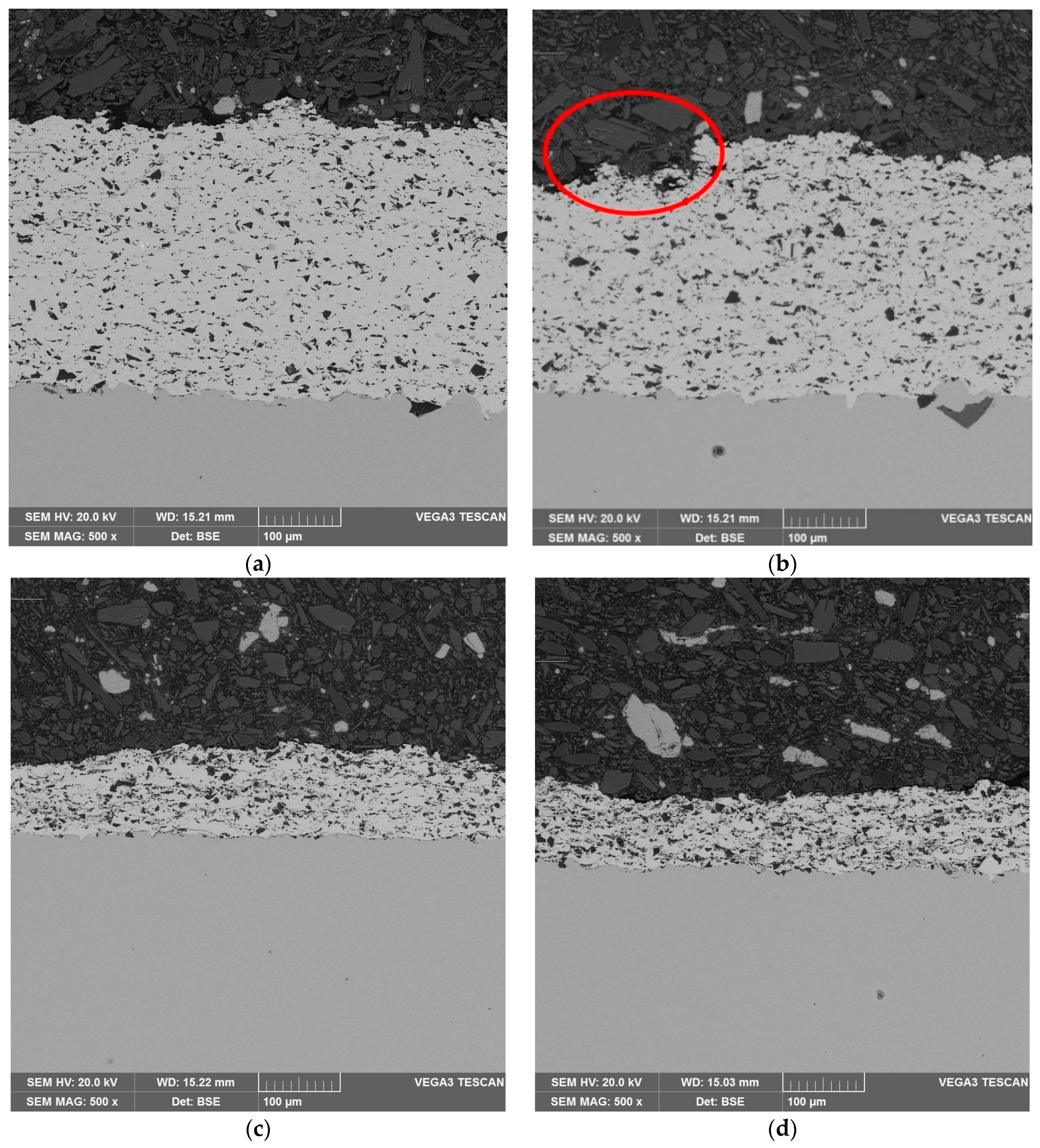
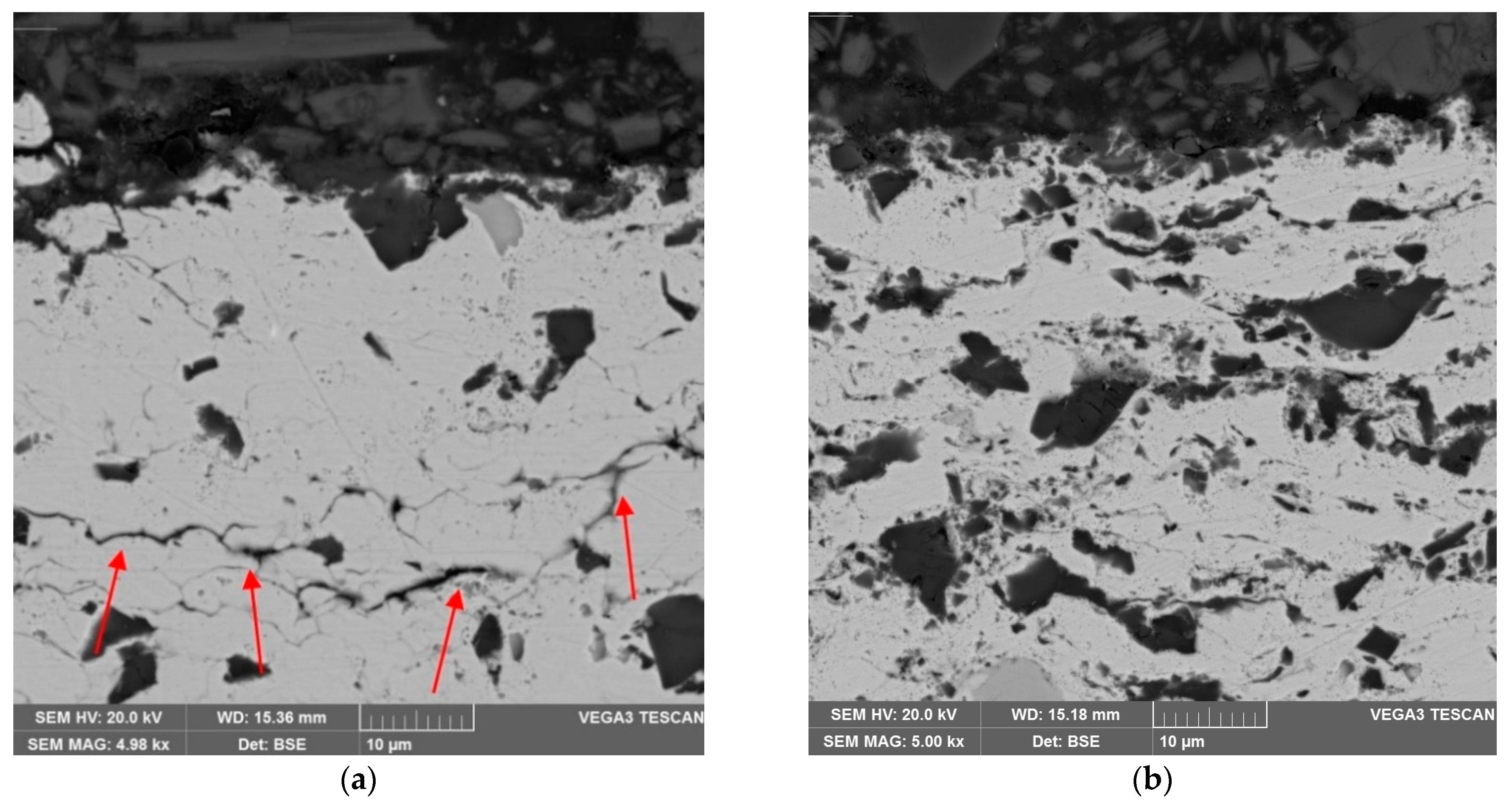
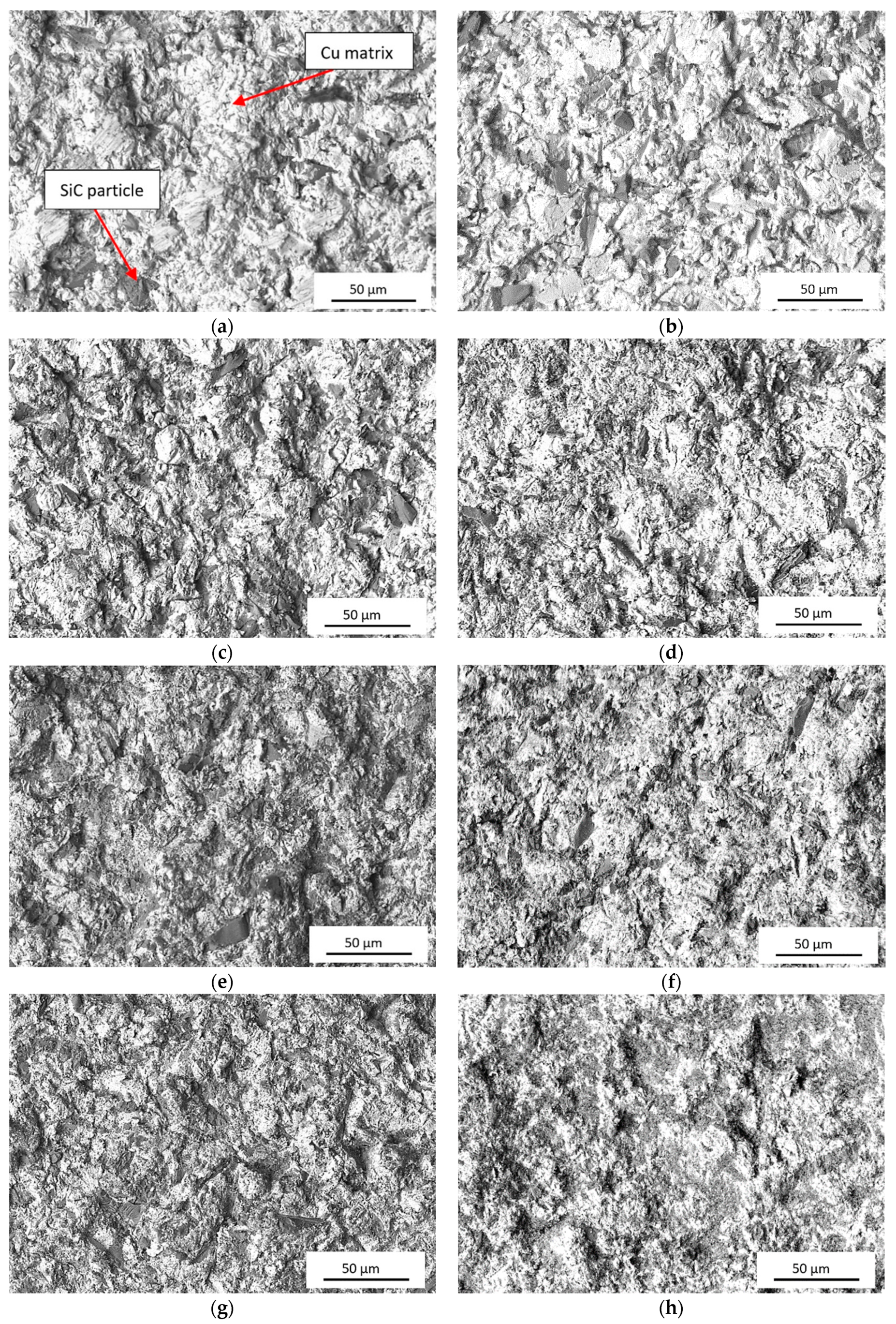


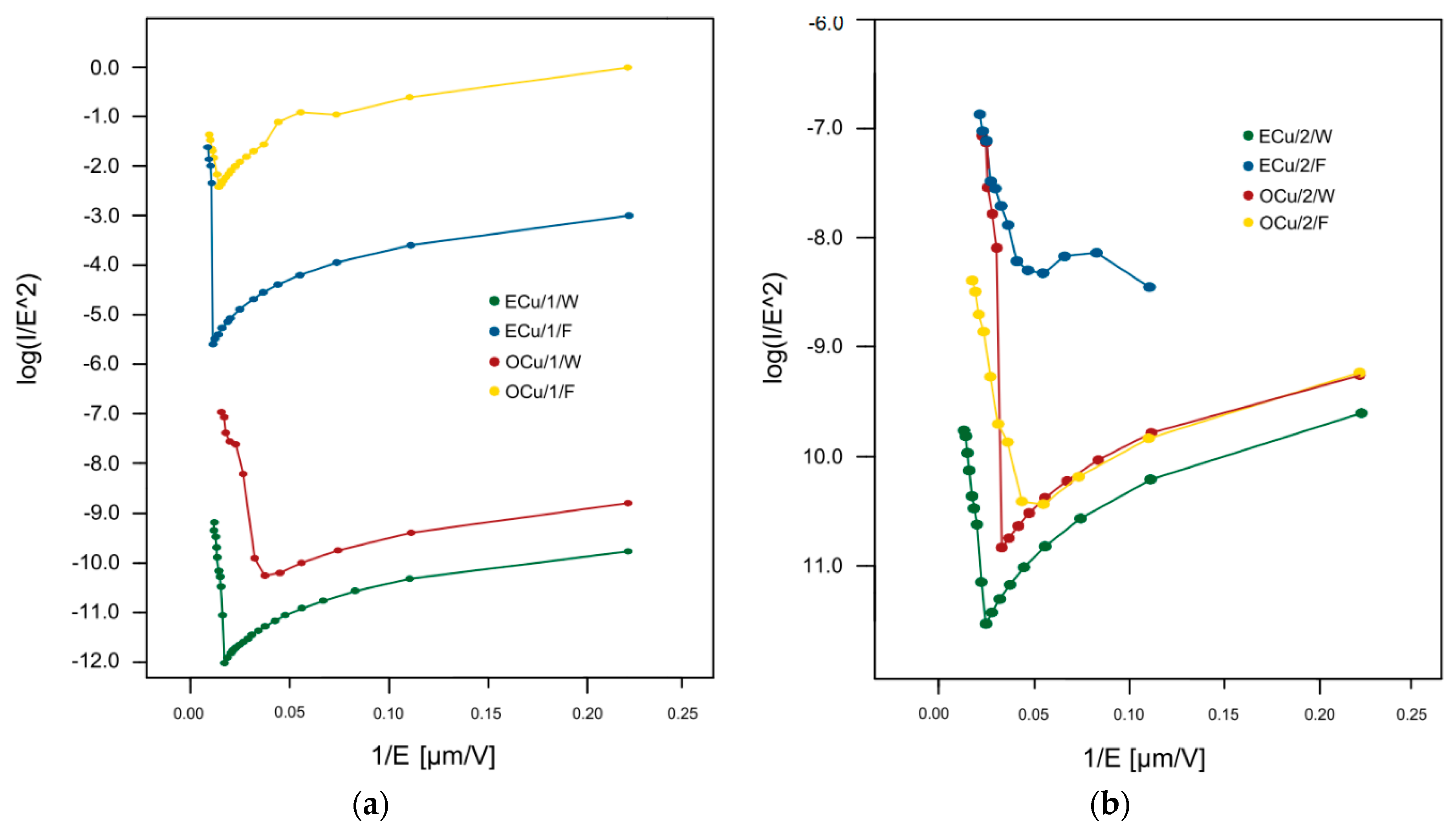
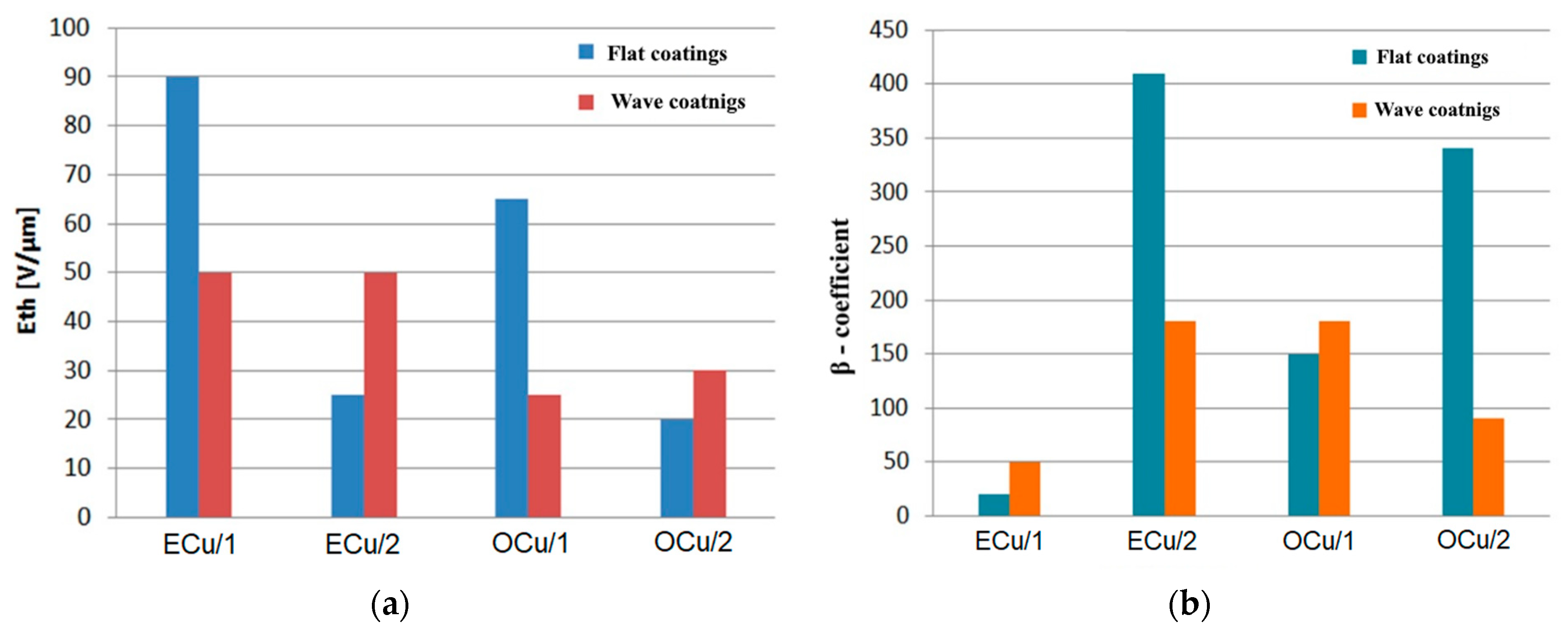
| Powder | Powder Feed Rate [g/min] | Traverse Scanning Speed, [mm/s] | Gas Pressure, [MPa] | Gas Temperature, [K] | Stand-Off Distance l [mm] |
|---|---|---|---|---|---|
| E-Cu/SiC | 20 | 10 | 0.9 | 773 | 10 |
| O-Cu/SiC | 20 | ||||
| SiC | 10 |
| Notation | Sample | Type of Copper Powder Morphology | Additional SiC Layer |
|---|---|---|---|
| ECu/1/F | E-Cu/SiC flat | Dendritic | − |
| ECu/1/W | E-Cu/SiC wavy | Dendritic | − |
| OCu/1/F | O-Cu/SiC flat | Spherical | − |
| OCu/1/W | O-Cu/SiC wavy | Spherical | − |
| ECu/2/F | E-Cu/SiC + SiC flat | Dendritic | + |
| ECu/2/W | E-Cu/SiC + SiC wavy | Dendritic | + |
| OCu/2/F | O-Cu/SiC + SiC flat | Spherical | + |
| OCu/2/W | O-Cu/SiC + SiC wavy | Spherical | + |
| Sample | Roughness Ra; Rz [µm] | Volumetric Amount of SiC Particles on the Coatings Surface [%] | Emitting Surface, [cm2] | Qualitative Description of Electron Emission Basing on the Range of Coefficient of Electric Field Amplification, β |
|---|---|---|---|---|
| ECu/1/F | 13.7; 33.8 | 30.2 | 4.51 × 10−6 | Very weak emission (β < 80) |
| ECu/1/W | 29.9 | 2.59 × 10−10 | Very weak emission (β < 80) | |
| OCu/1/F | 11.8; 27.8 | 37.5 | 1.39 × 10−8 | Weak emission (81 < β < 160) |
| OCu/1/W | 31.4 | 2.05 × 10−7 | Good emission (161 < β < 240) | |
| ECu/2/F | 17.6; 63.2 | 57.5 | 6.31 × 10−15 | Very good emission (β > 241) |
| ECu/2/W | 48.5 | 1.32 × 10−10 | Good emission (151 < β < 240) | |
| OCu/2/F | 14.8; 54.2 | 55.1 | 3.09 × 10−16 | Very good emission (β > 241) |
| OCu/2/W | 53.9 | 1.23 × 10−13 | Weak emission (81 < β < 160) |
Publisher’s Note: MDPI stays neutral with regard to jurisdictional claims in published maps and institutional affiliations. |
© 2021 by the authors. Licensee MDPI, Basel, Switzerland. This article is an open access article distributed under the terms and conditions of the Creative Commons Attribution (CC BY) license (http://creativecommons.org/licenses/by/4.0/).
Share and Cite
Winnicki, M.; Łapa, W.; Znamirowski, Z. Field Electron Emission Experiments with Cold-Sprayed Cu-SiC Composite Coatings. Coatings 2021, 11, 134. https://doi.org/10.3390/coatings11020134
Winnicki M, Łapa W, Znamirowski Z. Field Electron Emission Experiments with Cold-Sprayed Cu-SiC Composite Coatings. Coatings. 2021; 11(2):134. https://doi.org/10.3390/coatings11020134
Chicago/Turabian StyleWinnicki, Marcin, Wojciech Łapa, and Zbigniew Znamirowski. 2021. "Field Electron Emission Experiments with Cold-Sprayed Cu-SiC Composite Coatings" Coatings 11, no. 2: 134. https://doi.org/10.3390/coatings11020134
APA StyleWinnicki, M., Łapa, W., & Znamirowski, Z. (2021). Field Electron Emission Experiments with Cold-Sprayed Cu-SiC Composite Coatings. Coatings, 11(2), 134. https://doi.org/10.3390/coatings11020134







